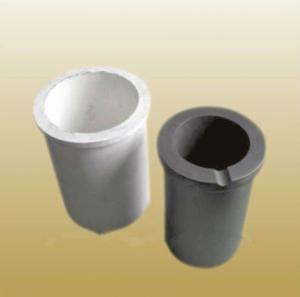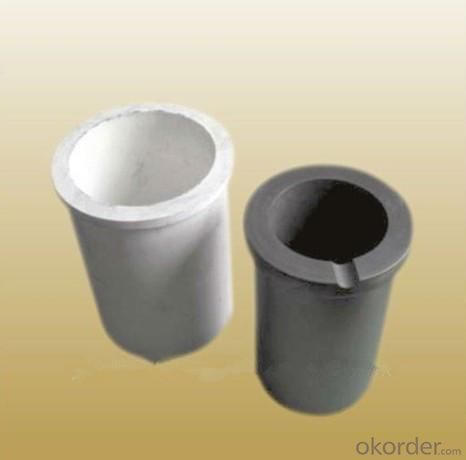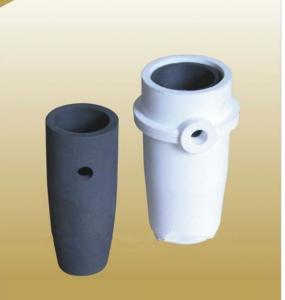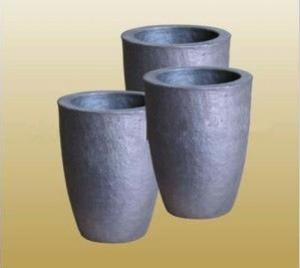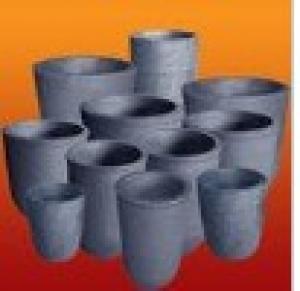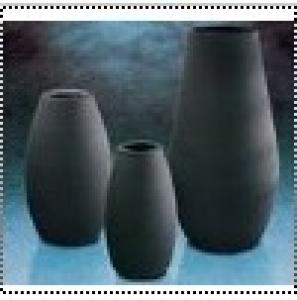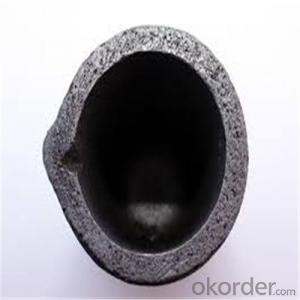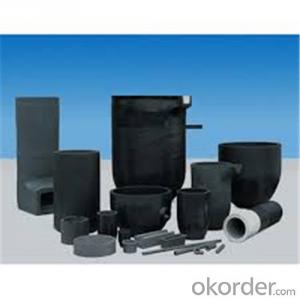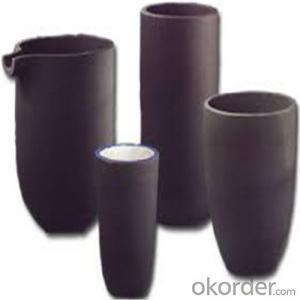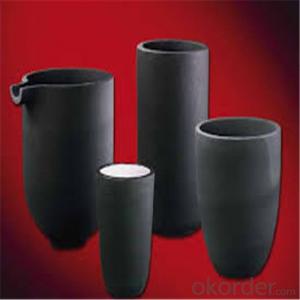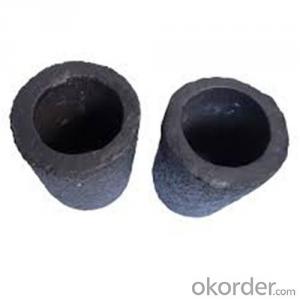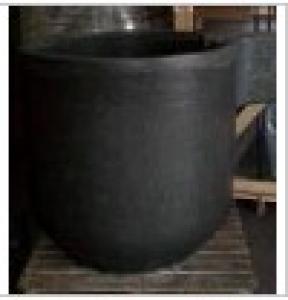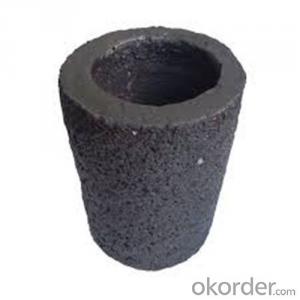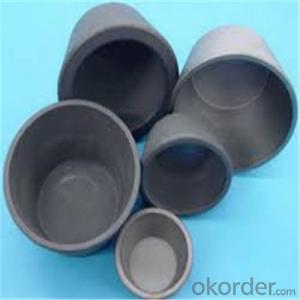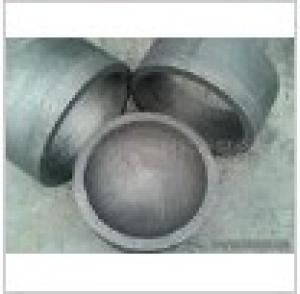Graphite Induction Melting Crucible Tongs
- Loading Port:
- China Main Port
- Payment Terms:
- TT or LC
- Min Order Qty:
- 5 Pieces pc
- Supply Capability:
- 10000 Pieces per Month pc/month
OKorder Service Pledge
OKorder Financial Service
You Might Also Like
Detailed Product Description
Graphite induction crucible sets
1.High pure graphite material.
2.Thermal stability, Corrosion resistance,Impact resistance
|
Isostaic graphite |
High pure graphite |
Extruded graphite | |
|
Estimated casting time |
250 |
160 |
80 |
|
Refractorines (degree centigrade) |
1800 |
1800 |
1400 |
|
Net weight of crucible |
Performance:
1. Thermal stability: According to the quench acute thermal using conditions of graphite crucible, we will specially design the production procedure, so as to ensure the reliability of product quality.
2. Corrosion resistance: Even and fine basic design will delay the erosion of crucible.
3. Impact resistance: Graphite crucible can bear high thermal impact, so any process can be carried out.
4. Acid resistance: The adding of special materials will greatly improve the quality of crucible, especially its index of acid resistance., and will prolong the service life of graphite crucible.
5. High heat Conduction: High content of fixed carbon ensures the good heat conduction, shorten the time of dissolution, and remarkably reduce the energy consumption.
6. Control of metal pollution: The component of material under strict control will ensure that graphite crucible will not pollute the metals when dissolving.
7. Quality stability: The process technology of forming under high pressure and quality guarantee system will fully ensure the stability of quality
- Q: Can graphite crucibles be used for thermal analysis?
- No, graphite crucibles are not typically used for thermal analysis. Graphite crucibles are mainly used for high temperature applications such as melting and casting metals, as well as for chemical reactions that require high heat. In thermal analysis, different techniques are used to study the physical and chemical properties of materials as they undergo changes in temperature. These techniques include differential scanning calorimetry (DSC), thermogravimetric analysis (TGA), and thermal conductivity measurements, among others. For these types of analyses, specialized equipment and materials are required. Typically, ceramic or metal crucibles are used as they have better thermal conductivity and stability at high temperatures, ensuring accurate and reliable measurements. These crucibles are designed to withstand thermal cycling and provide a controlled environment for the sample being analyzed.
- Q: How do you prevent graphite crucibles from sticking to the melted material?
- One way to prevent graphite crucibles from sticking to the melted material is by applying a suitable release agent or coating to the surface of the crucible. This can create a barrier between the crucible and the melted material, preventing them from adhering to each other. Additionally, maintaining proper temperature control and ensuring the crucible is properly preheated before adding the melted material can also help minimize sticking.
- Q: Can graphite crucibles be used for melting iron?
- No, graphite crucibles cannot be used for melting iron. While graphite crucibles are commonly used for melting metals such as gold, silver, and copper due to their high thermal conductivity and resistance to high temperatures, they are not suitable for melting iron. This is because iron has a much higher melting point compared to other metals, reaching around 1,535 degrees Celsius (2,795 degrees Fahrenheit). Graphite crucibles have a limit to their operating temperature, typically around 1,200 degrees Celsius (2,192 degrees Fahrenheit) or lower. Therefore, when exposed to the extreme heat required to melt iron, graphite crucibles would be at risk of breaking down, losing their structural integrity, and contaminating the molten iron. For melting iron, materials with higher melting point and better resistance to high temperatures, such as clay-graphite or silicon carbide crucibles, are preferred. These crucibles can withstand the intense heat required to melt iron and maintain their shape and integrity. It is important to select the appropriate crucible material based on the specific metal being melted to ensure safety, efficiency, and quality in the melting process.
- Q: Can graphite crucibles be used for melting bronze?
- Yes, graphite crucibles can be used for melting bronze.
- Q: Can graphite crucibles be used for diamond synthesis?
- No, graphite crucibles cannot be used for diamond synthesis. While graphite and diamond are both forms of carbon, they have different structures and properties. Graphite has a layered structure with weakly bonded layers, making it a good conductor of electricity and heat. On the other hand, diamond has a three-dimensional structure with strong covalent bonds between carbon atoms, making it the hardest known substance and a poor conductor of electricity. In the process of diamond synthesis, high temperatures and pressures are used to convert carbon into diamond. Graphite crucibles are unable to withstand these extreme conditions and would react with the carbon, leading to the formation of more graphite rather than diamond. To synthesize diamonds, specialized equipment such as high-pressure, high-temperature (HPHT) or chemical vapor deposition (CVD) methods are used, which require different materials capable of handling the required conditions.
- Q: How does the thermal conductivity of the molten metal affect the performance of a crucible?
- The performance of a crucible is determined by the thermal conductivity of the molten metal, which plays a crucial role. Thermal conductivity refers to a material's ability to conduct heat, and in the case of a crucible, it directly impacts its ability to withstand and distribute high temperatures. A high thermal conductivity in the molten metal enables faster heat transfer from the crucible, leading to a more uniform distribution of heat. This is advantageous as it allows for quicker and more efficient melting or heating of the metal inside the crucible. It also helps maintain a consistent temperature throughout the crucible, which is vital in certain industrial processes that require precise temperature control. Conversely, a low thermal conductivity in the molten metal can have detrimental effects on the performance of a crucible. It can cause uneven heat distribution, resulting in hot spots or cold spots within the crucible. This unevenness can lead to inconsistent melting or heating of the metal, resulting in poor quality or incomplete reactions in industrial processes. Moreover, the lack of efficient heat transfer can potentially cause overheating in certain areas of the crucible, leading to premature failure or damage. In conclusion, the thermal conductivity of the molten metal directly impacts the performance of a crucible. A high thermal conductivity enables faster and more efficient heat transfer, leading to better temperature control and more effective industrial processes. Conversely, a low thermal conductivity can cause uneven heat distribution and potential damage to the crucible, thereby compromising its performance.
- Q: How to calculate the loss of aluminum slag melting?
- Look at the size of aluminum slag, big saw recovery rate is high, small saw fine chip is low.
- Q: Can graphite crucibles be used for melting rare earth metals?
- Yes, graphite crucibles can be used for melting rare earth metals. Graphite is known for its high melting point, good thermal conductivity, and resistance to chemical reactions, making it an ideal material for high-temperature applications such as melting rare earth metals. Additionally, graphite crucibles are durable and can withstand the harsh conditions of molten metals, making them a suitable choice for melting and refining rare earth metals. However, it is important to note that some rare earth metals, such as cerium, can react with graphite at high temperatures, leading to the formation of carbonates. Therefore, it is advisable to consult the specific properties and reactivity of each rare earth metal before using graphite crucibles for melting.
- Q: Graphite can react with alkali in high temperature
- Graphite is a very stable carbon element. Generally in time, high temperatures generally do not react with bases.
- Q: Are there any special precautions to be taken while using graphite crucibles?
- While using graphite crucibles, it is essential to take special precautions into consideration. Careful handling is crucial as these crucibles are delicate and prone to breakage. To prevent cracks or damage, it is important to avoid dropping or mishandling them. Furthermore, storing graphite crucibles in a clean and dry environment is necessary to prevent contamination. Impurities from the surroundings can be absorbed by graphite, impacting its performance and durability. Hence, maintaining a contamination-free storage space is advised. To avoid thermal shock, which can cause cracks or breakage, it is crucial to refrain from subjecting graphite crucibles to sudden temperature changes. Gradually heating or cooling the crucible within the recommended temperature range is recommended to prevent thermal shock. Prior to initial use, it is important to properly season or preheat the graphite crucible. This process involves slowly heating the crucible to a specific temperature to eliminate any moisture or volatile substances present. Neglecting to season the crucible appropriately can result in cracking or premature failure during subsequent use. Additionally, it is vital to avoid overloading the crucible with excessive material, as graphite crucibles have specific capacity limits. Overloading can lead to crucible failure or reduce its lifespan. Lastly, when handling molten materials or pouring them into the crucible, it is essential to wear suitable personal protective equipment. This includes heat-resistant gloves, face shields, and other protective clothing to prevent burns or injuries. By adhering to these precautions, users can ensure the safe and effective use of graphite crucibles while maximizing their lifespan and performance.
1. Manufacturer Overview
| Location | Guangdong,China (Mainland) |
| Year Established | 2010 |
| Annual Output Value | |
| Main Markets | North America South America Eastern Europe Southeast Asia Africa Oceania Mid East Eastern Asia Western Europe |
| Company Certifications |
2. Manufacturer Certificates
| a) Certification Name | |
| Range | |
| Reference | |
| Validity Period |
3. Manufacturer Capability
| a) Trade Capacity | |
| Nearest Port | |
| Export Percentage | 61% - 70% |
| No.of Employees in Trade Department | |
| Language Spoken: | |
| b) Factory Information | |
| Factory Size: | 1,000-3,000 square meters |
| No. of Production Lines | Above 10 |
| Contract Manufacturing | OEM Service Offered |
| Product Price Range | |
Send your message to us
Graphite Induction Melting Crucible Tongs
- Loading Port:
- China Main Port
- Payment Terms:
- TT or LC
- Min Order Qty:
- 5 Pieces pc
- Supply Capability:
- 10000 Pieces per Month pc/month
OKorder Service Pledge
OKorder Financial Service
Similar products
Hot products
Hot Searches
Related keywords
